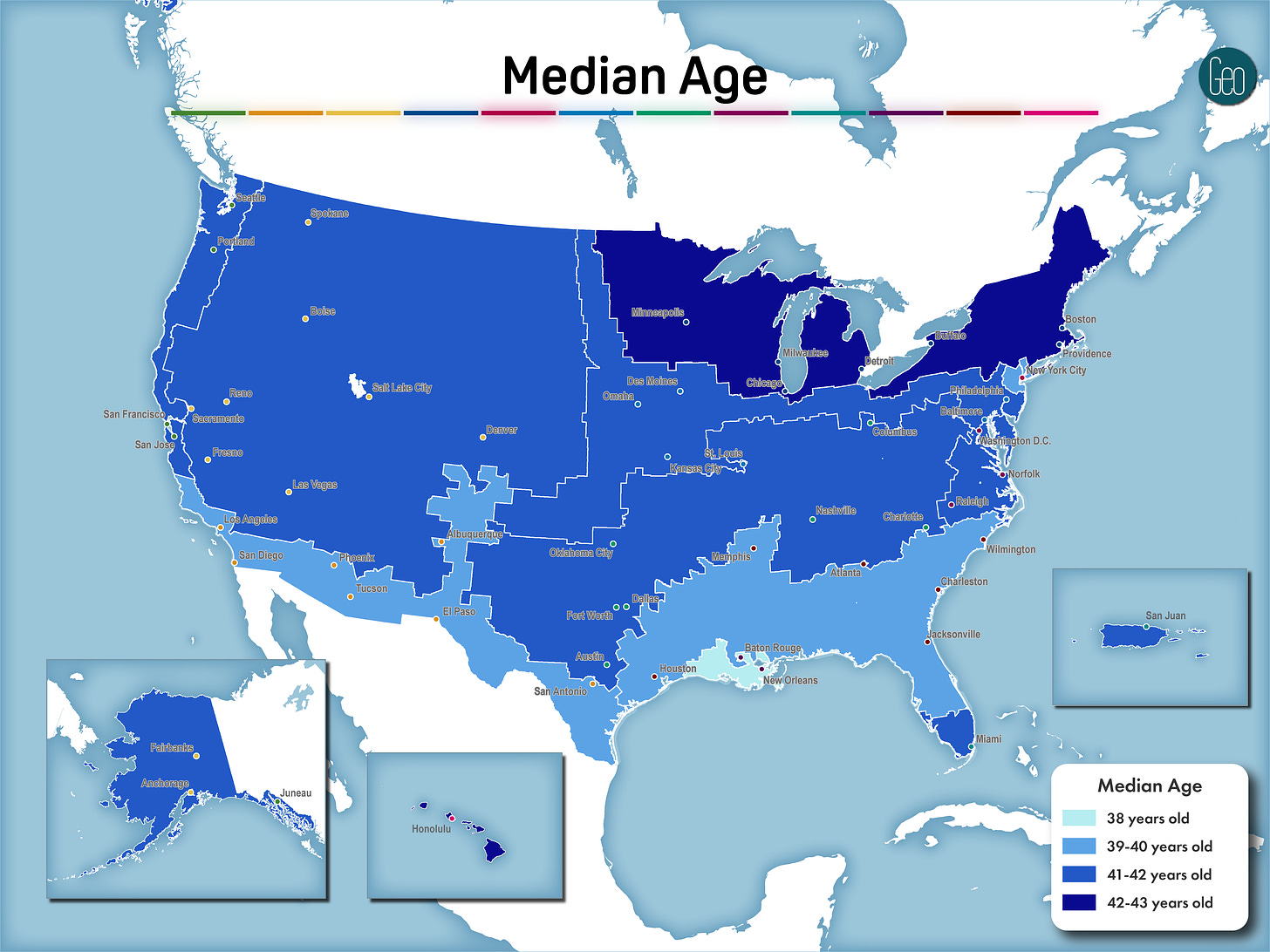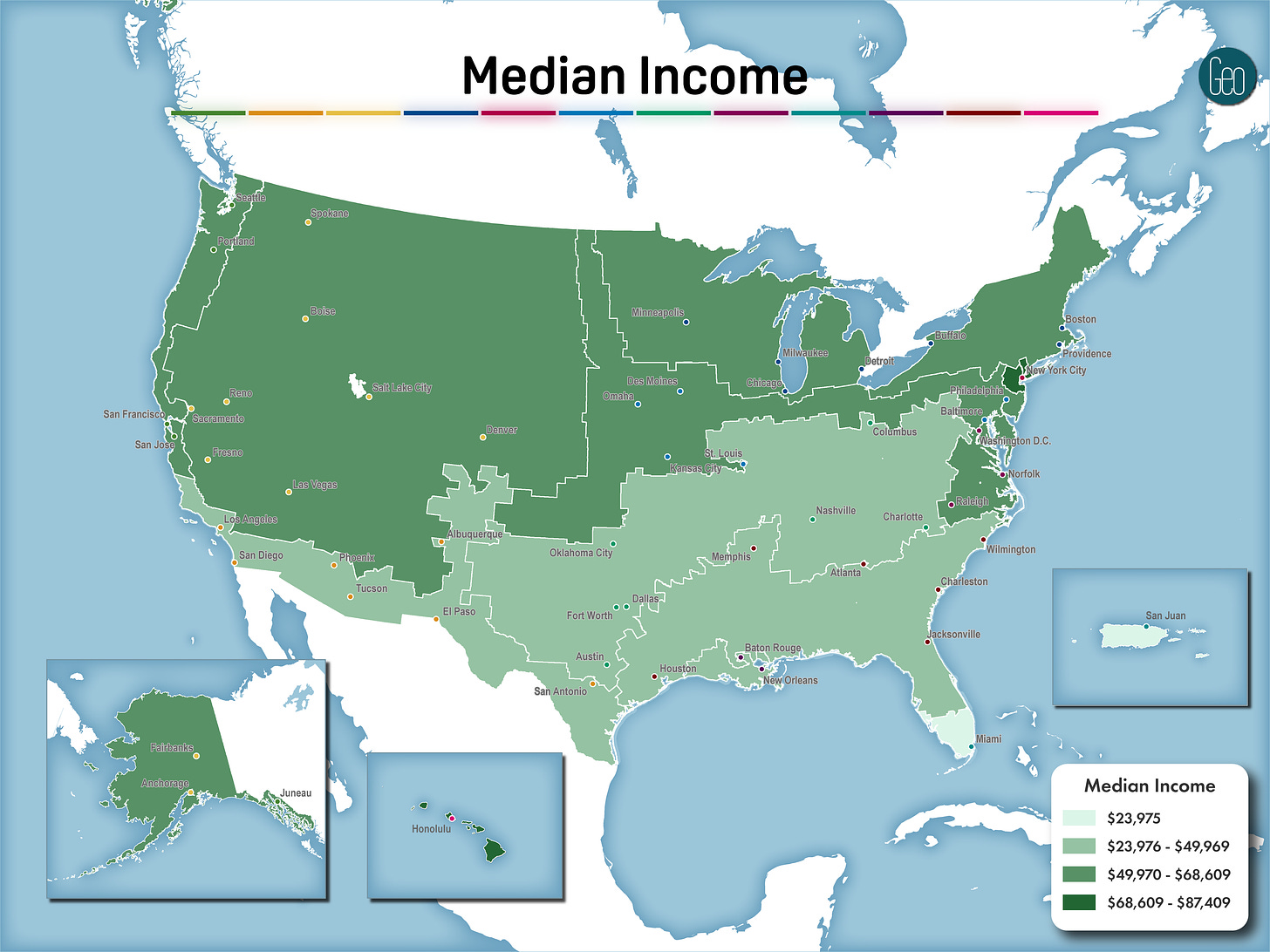The American Nations: Data Breakdown (Part 2)
Now that we know what the American nations are, let's break them down a bit using county-level census data.
Welcome to the second part in a now two-part map series on the “American Nations” theory of cultural nationalities that exist within the United States. Originally this was intended to be a three-part series, but given that the heat dome already delayed this by a week, I’m just going to keep it as a two-part. Really I just kind of want to move on. I’m also simply tired of culling through census data at this point. Anyway, on to the data!
—
If you remember from a couple weeks ago, based on Collin Woodard’s book “American Nations,” the United States is actually comprised of multiple nations based on a number of historical and cultural aspects. If you’re just now diving in, I highly recommend you take a look at part-one as it goes into some of the characteristics of each nation. But either way, take a look at the map above, to get an idea of the extents of each nation because we’re doing some deep data-diving from here on out!
Data caveat: As usual, there’s a small data caveat. In a Twitter exchange with Woodard, he explained to me that there were a number of “split” counties in his original assessment that I didn’t notice and didn’t account for in the original article. This would include places like Cook County, Illinois (home of Chicago) and Orleans Parish (home of New Orleans). Given that census data is already challenging to compile and gather and I only have so much time, I opted to not make this split. Given the scale of each nation, I do not believe it’ll have too much impact on the trends we see.
Population Density
No big surprises here. The smaller the area, typically the more dense the nation is. So it makes sense that New Netherlands and the Spanish Caribbean show up here. I would say the only two mild surprises are the relative low density of New France and the relative high density of The Left Coast. But otherwise, everything else is basically as expected. The Far West, as you can probably guess, is the least dense nation.
Median Age
Now we get into some more interesting data. In modern population geography, we tend to look at the average age of a population to determine things like resource distribution and future prospects (a younger average age means more tax money in the future). Along with New France, who has the lowest median age, we see that New Netherlands, El Norte and The Deep South have a bit of an advantage in this regard with an average age of 39-40 years old. Meanwhile Hawaii is actually trending the oldest. This is likely due to a combination of retirees moving there and an overall low birth rate.
Median Income
Hawaii and New Netherlands lead in terms of median income with the Spanish Caribbean bringing up the rear. For Hawaii and New Netherlands, while this is not too surprising, I do wonder how well each would perform on a cost of living basis. Hawaii, in particular is well known for being a very expensive place to live. In looking a little closer at the Spanish Caribbean, Puerto Rico is definitely bringing the whole nation down a little bit. Despite being a US territory, they have not received nearly the same level of support from the federal government of the USA and it shows here. Hopefully one day they’ll be a full state and this will change.
Education
Education was a tough one, but since Woodard made it such a large part of his book, I figured I had to take a look. In terms of what he wrote, I’m finding that the data definitely backs it up to an extent. The New Netherlands, Left Coast, Hawaii and Yankeedom all had the highest levels of educational attainment on a collegiate level. But when I looked at the inverse of high school graduation rates I saw a similar inverse pattern.
El Norte, Greater Appalachia, New France and the Deep South all have higher percentages of people with no high school diploma. A wide variety of factors are included in this, I’m sure, but one that I recall from Woodard’s book was the trust and belief in (or lack of) the educational institutions that some nations have and others don’t.
The Spanish Caribbean is doubly interesting because it shows up on both with a higher percentage of college graduates and a higher percentage of those with no high school diploma. South Florida is well known for its migrants from the northeast USA so maybe there’s a connection there.
Births
And finally, we have births. This was just an interesting dataset that I saw. I don’t know if it’s really telling us any interesting trends between the nations, but overall I thought it was an interesting metric to see which might have a higher birth rate. I don’t want to comment on it too much though so I’ll just kind of leave it as is, and let you make your own conclusions.
Woodard’s book is an interesting concept. Originally, I was going to spend another week to go over criticisms, and data to showcase those criticisms, but, as I mentioned earlier, I’m ready to move on. That said, I’ll highlight just a couple things I’ve been mulling over in the past couple weeks that poke some holes in his theory.
The first is that while historically these nations might have existed, I’m not sure they fully take into account the blending of cultures as people move from one nation to another. If someone moves from Atlanta to Seattle, are they really more aligned with The Left Coast than The Deep South? Probably not, or at least not for a while. And especially in this day and age of social media where cultural boundaries are getting fuzzy even across actual political borders, I don’t see how a true “Left Coast” culture could maintain itself. Instead, what I see today are cultures more around the way in which we live which leads me to my next criticism.
Woodard’s theory doesn’t really account for what we’ve been seeing over the last 10 years: the schism between urban and rural residents. I would argue that I, as someone living in the heart of Portland, Oregon, have more in common with someone living in the heart of Philadelphia, Pennsylvania, than I would with a rural resident in a small town a few hours outside of Portland. That’s not to say we don’t have any commonalities, but rather they are more distinct between urban-rural and Woodard’s nations.
American definitely has more than one culture. I won’t deny that. And I’m not saying Woodard’s cultural nations don’t exist either. I think he puts forth a compelling argument and much of it holds true, especially historically. It’s been a fun concept to explore over the last few weeks. I hope you’ve enjoyed it, but if not, don’t worry, I’ll dig into something a bit less in the clouds next week.











Interesting take, but your example of a person from ATL moving to SEA is off. That person is NOT going to have the standard social profile for "membership" in The Deep South. Talked to a talented painter this last weekend, he moved to the California Central Coast from Atlanta. His friends were horrified and worried for his health and safety. The perception that the Left Coast is crime ridden and has a horrible quality of life is WIDESPREAD in more areas than just The Deep South. He and my wife were laughing about it, as she had the same reaction from family all over The Deep South when she moved to California just recently. The perfect mobility of labor isn't a thing, but self migration to more identity compatible "nations" seems to be. Really enjoyed this, I sent a link to my wife.